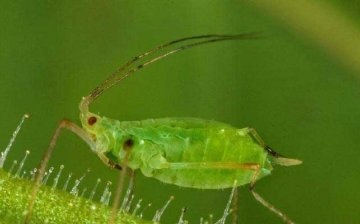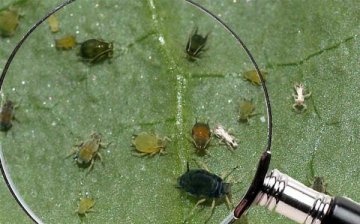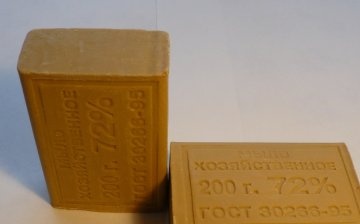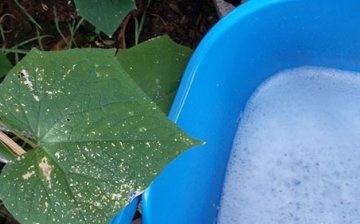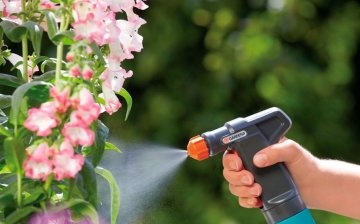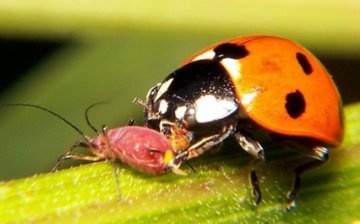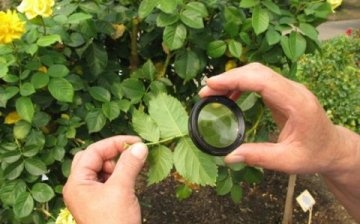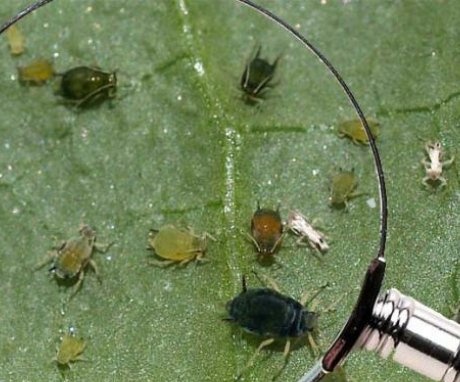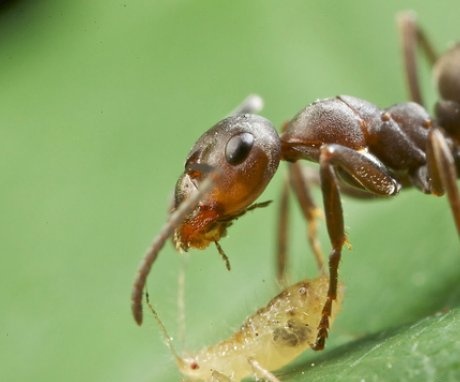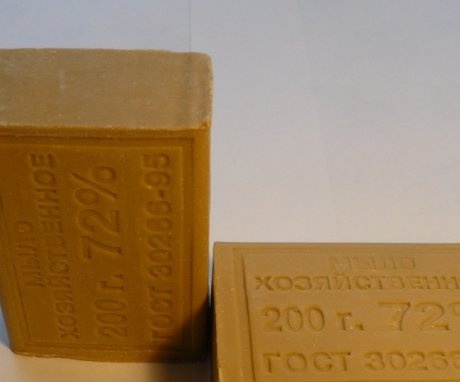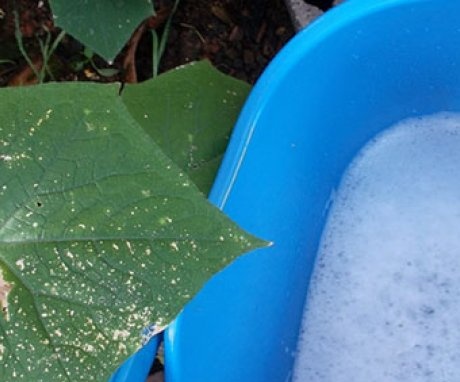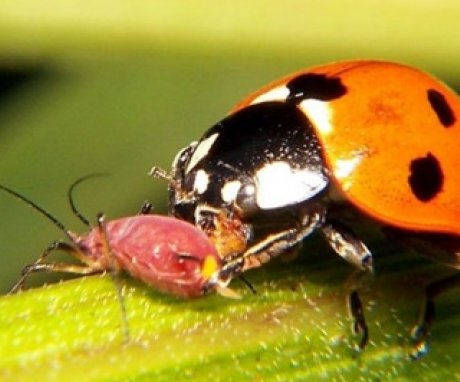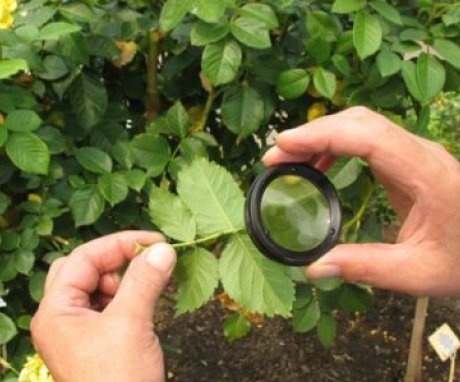The most effective aphid remedies
Every spring, gardeners await with horror the appearance of the most malicious pest - aphids. She, without pity and without delay, destroys young shoots of fruit and berry and vegetable crops, trees and shrubs, favorite flowers suffer.
Every year, the grower has to come up with new ways to deal with pest, since the old ones no longer work. There is no escape from the aphids, it appears again and again. It remains to roll up our sleeves and start exterminating the infection using new methods, otherwise there is a risk of being left without a crop. In this useful guide, the gardener will learn all the ins and outs of the pest, respectively, he will understand how to correctly deal with it and what strategy to choose - everything is like in war!
Content:
- Types of pests - what is she, aphids
- What damage does a pest do in the garden
- Safe methods of struggle
- Chemicals and their types
- Biological control of aphids
- Preventive measures
Types of pests - what are they, aphids
The insect often has the shape of an ellipse, a transparent body and rather long legs. The size of the aphid is small and ranges from 1 to 2 mm. The color of the pest is different, it depends on which plant aphids parasitize - red, black, green, pale yellow. Aphids form entire colonies on the host plant. They succeed in this thanks to operational reproduction.
It all starts with the larva that appeared in the spring from the clutch left by the female for the winter. These larvae reproduce themselves, they do not need males. During the season, up to 10 generations are born, among which there will be aphids with wings - females. Their task is to move from the host plant to a new one and give offspring. Males with wings appear only in autumn on a new plant. They again migrate to the former host plant and fertilize females there, the offspring of which remain for the winter. This is the life cycle of the parasite.
They feed on aphids on plant juices, and many species of insects can parasitize on any crops.
Aphids have a proboscis for piercing a leaf. They cannot bite through the coarse and dense leaves of the plant. Therefore, they prefer to drink juices from young plants, shoots, buds - the apical part of crops. In spring, the young foliage of trees is always in great danger, since the leaves are still soft and tender.
Aphids have an unprotected cover, they are easy to crush. They are often attacked by both bird and insect predators. Therefore, aphids twist the leaves into a tube - so it is not easy to get them. Keep this in mind when dealing with a pest. The methods for killing aphids on trees and other crops are the same for all species.
What damage does the pest do to the garden
The harm caused by aphids:
- Aphids suck out plant juices. This leads to a slowdown in the development of cultures. Young shoots curl up, the leaves dry out. If you do nothing, you can be left without a crop. It is necessary to protect trees from parasites during the period flowering, aphids are very active during the budding period of crops. They eat the harvest in its embryonic state - flowering.
- Also, aphids are capable of carrying viral plant diseases, which has a deplorable effect on the harvest.
The whole problem is that aphids move from one plant to another with the help of ants.They love the sweet juice secreted by aphids. Ants take care of parasites in every possible way and carefully transfer them from one feeding place to another. Thus, the whole vegetable garden is in danger.
It is necessary to destroy not only pestbut also ants. In fact, it is not difficult to destroy aphids. The main thing is to catch them in the spring, when the first leaves of plants and trees have not yet appeared. Knowing the life cycle of the enemy, his weaknesses, you can safely choose ways to combat parasites.
Safe methods of struggle
FROM pests can be dealt with using safe, folk methods. Since the parasite is easy to kill thanks to its unprotected cover, it is enough process plant with a solution that contributes to the death of insects.
In all the proposed variants of the struggle, soap appears, preferably household soap.
Why is it needed? The fact is that the addition of soap shavings binds the solution. The composition "sticks" to the foliage much better. Therefore, this ingredient is added to all solutions. Moreover, aphids do not tolerate soap, the foliage becomes unsuitable for collecting juice.
Traditional methods and recipes:
- Soap solution. This method is very popular and accessible to every gardener. It effectively cleans the plant from the parasite and does not harm the culture and humans. Laundry soap is used for cooking. The bar is rubbed on a grater to obtain shavings. 10 liters of water will require 300 g of soap shavings. Dissolve soap thoroughly in warm water. Stir until completely dissolved. Then pour the solution into a special apparatus and proceed to spraying... It is better to do this in early spring, when the tree buds are slightly bent. The second treatment is carried out at the stage of blossoming leaves, the third - before and in the field flowering... Also, don't forget about ants. Having found their settlement, scald "their house" with boiling water.
- Garlic and onion. Garlic and onions are often harvested as a concentrate, which is diluted with water before spraying. You will need 200 g of garlic and 100 g of onions (bulbs, not feathers). Grind the raw materials and fill with a liter of warm water. Insist for 3 days in a cool, dark place. The concentrate is diluted in a ratio of 30 ml to 10 l of water. Soap shavings are added to the solution - 15 g. Process crops in early spring until the first foliage appears in the trees. Second treatment before flowering. Do not forget that any processing of plants is carried out 15-30 days before harvesting, regardless of what means the crop is irrigated with - plant or chemical.
- Dandelion is not a weed, but a helper. Every gardener zealously begins to fight dandelions from early spring. However, do not throw away weed... The whole plant, along with the roots, will help defeat aphids. This will require 1 part of the roots and 2 parts of the leaves. Pour raw materials with warm water, 10 liters, and leave for 5 hours. Into the solution before spraying add 15 g of soap shavings. Crops are processed in the same way - before the appearance of leaves, before flowering and 15-30 days before harvest. Some gardeners add to the dandelion solution garlic... However, the result is a "pungent" mixture that can burn tender, young foliage.
- Ash solution and soap. This is another very popular aphid control method. Wood ash has many beneficial properties, including repelling insects. For the solution, you will need 300 g of ash and 50 g of soap. First, the ash is diluted with water, 10 liters. The liquid must be boiled for 30 minutes and cooled. Dissolve the soap in a warm solution. If a lot of water has boiled away, it is necessary to add liquid up to 10 liters. The crops should be sprayed according to the already known scheme. Ash in tandem with soap is a well-known agent that is effective and safe for crops and humans.
- Burdock and soap. Burdock is another weed that gardeners are trying to get rid of. Weed out the area from the burdock, do not throw away the greens. It will come in handy in the fight against aphids.300 g of burdock leaves must be infused in 10 liters of warm water for 2 days. Then add 40 g of soap shavings to the solution. Spray before blooming, until flowering and after. In addition to fresh raw materials, dry plant leaves can also be used. The only difference will be in proportions. Two times less dry raw materials are added than fresh ones. That is, divide all proportions in half.
If the colony of aphids is too large, large areas of the garden are affected, most likely folk methods cannot be dispensed with. We'll have to resort to "heavy artillery" - chemicals.
Chemicals and their types
As much as the gardener wants to use chemistry on the site, sometimes you can't do without it. To combat aphids, the entire arsenal of chemicals belonging to the groups is used:
- Contact
- Intestinal
- Systemic
To combat aphids, the first two groups are often used. Contact drugs immediately act on parasites, and intestinal drugs affect the digestive system of insects. That is, those that did not fall under the attack of a contact chemical will certainly fall under a different type of insecticide.
You should pay attention to chemicals that contain a minimum amount of chemical poisons. The ratio is considered safe - enough to kill aphids and not enough to harm plants and humans. These include:
- Fitoverm
- "Arrow"
- "Biotlin"
- "Entobacterin"
These drugs are widely used by gardeners and do not cause significant harm to crops. Solutions with the use of drugs are prepared in accordance with the instructions on the packages.
If these funds do not help, you will have to resort to strong chemicals. As a rule, they are of a systemic nature and penetrate into the cellular structure of the plant. Parasites, eating such a delicacy, die. Strong-acting drugs include:
- "Kinmix"
- "Intavir"
- "Spark"
These are the most popular remedies that can be found at any garden store. However, you need to be extremely careful with them. Use clothing suitable for handling chemicals and strictly observe the dosage indicated on the package. It is necessary to spray plants with chemicals 30-40 days before harvesting. Try to do the processing before the flowering phase.
Biological control of aphids
Control measures include the so-called biological methods for the destruction of parasites. Aphid-repelling plants are planted around trees and shrubs. They attract insects to the site with the help of the same planting of certain crops that eat pests-sokopiets. Preventive measures also include early treatment of trees with solutions from aphids.
Plants that repel parasites include:
- Dalmatian chamomile is a natural insecticide.
- Garlic planted in close proximity to fruit trees.
- Onion try to place around the perimeter of the entire site, especially next to trees and shrubs.
Many gardeners grow plants that attract aphids away from vegetable crops and fruit trees. Parasites gather there and are not distracted by the cultures that a person needs. These include:
Aphids literally "stick" to these plants. Keep this in mind and use this knowledge when planning your site. In addition to useful plantings, plant breeders prefer to "breed" cute ladybirds in the garden. After all, they and their larvae eat aphids with pleasure. In garden stores, you can purchase helper insect larvae and breed them in sufficient quantity to fight the parasite. However, when resorting to the help of ladybirds, you should forget about the use of both safe and chemical solutions.
Aphids are also fought with the help of birds. Birds are attracted to the site with the help of feeders and drinkers, they will gladly cleanse the garden of all evil spirits. Feathered helpers include: sparrows, titmice, wrens, linnet and warblers.
Birds and ladybugs are not the whole spectrum of biological attack on aphids - there are a number of insects that eat parasites no worse than a ladybug.
These are: lacewings, hoverflies (flies), wasps (several species), earwigs, predatory bugs and ground beetles. To attract these beneficial insects, it is enough to plant spices - Dill, parsley and carrot... They also love daisiesrespect the shadow fern and prefer to huddle in bark mulch. Plan the planting of crops so that all useful plants, and with them the helper insects, are located near fruit trees and vegetable crops.
Preventive measures
Our ancestors fought against aphids long before their appearance on trees and bushes. To do this, they treated the trunks with lime and fumigated the plants with tobacco smoke. In early spring, when the snow melts, gardeners begin to process the fruit with tobacco. For this, dry tobacco leaves (makhorka) are placed in a tin can and set on fire. The jar is covered with a lid and left to smoke under the trees. The greenhouse is treated in the same way.
Tobacco smoke is not the only activity that takes place in the garden prior to planting. Greenhouse farms should also be carefully prepared. The earth and inventory are disinfected. And in the fall, all vegetation is necessarily removed and burned if it was affected by aphids. That is, you need to destroy all possible storage sites for aphid eggs.
If the garden was affected by aphids in the previous year, all vegetation attacked by the parasite must be collected and burned.
Otherwise, in the spring, aphids attack crops again. Any breathable material impregnated with a chemical agent from ants is attached to tree trunks in spring. You can't let your friends aphids in the trees. In the process of growing crops, strive to achieve good foliage turgor. This is achieved with the help of phosphorus-potassium top dressing, timely watering, by sprinkling. Dense leaves of aphids cannot bite through. Loosen the soil in time, remove peeling bark from trees. Whitening trunks in the spring is an easy way to kill aphid eggs.
We can separately mention the sprinkling procedures. Simulating rain helps to wash away the emerging parasites. Sometimes at the initial stage of development pests just direct a stream of water towards trees and shrubs. It will wash away the aphids if there are not many of them yet. Spray the plants often with plain water.
Now the gardener knows all the most effective pest control measures. Knowing the life cycle of an insect, you can quickly get rid of the parasite. Keep an eye on your green pets and take action in time when aphids appear.
More information can be found in the video:



